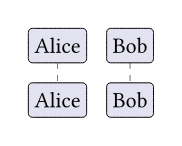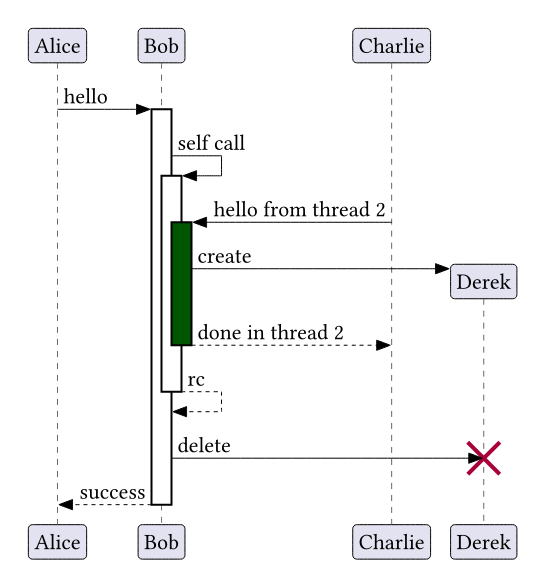
| Typst | Result |
| ```typst #import "@preview/chronos:0.1.0" #chronos.diagram({ import chronos: * _par("Alice") _par("Bob") }) ``` |  |
| Typst | Result |
| ```typst #chronos.diagram({ import chronos: * _par("Alice") _par("Bob") _seq("Alice", "Bob", comment: "Hello") _seq("Bob", "Bob", comment: "Think") _seq("Bob", "Alice", comment: "Hi") }) ``` |  |
| Typst | Result |
| ```typst #chronos.diagram({ import chronos: * _par("A", display-name: "Alice") _par("B", display-name: "Bob") _par("C", display-name: "Charlie") _par("D", display-name: "Derek") _seq("A", "B", comment: "hello", enable-dst: true) _seq("B", "B", comment: "self call", enable-dst: true) _seq("C", "B", comment: "hello from thread 2", enable-dst: true, lifeline-style: (fill: rgb("#005500"))) _seq("B", "D", comment: "create", create-dst: true) _seq("B", "C", comment: "done in thread 2", disable-src: true, dashed: true) _seq("B", "B", comment: "rc", disable-src: true, dashed: true) _seq("B", "D", comment: "delete", destroy-dst: true) _seq("B", "A", comment: "success", disable-src: true, dashed: true) }) ``` |  |
| Example | Features |
|
`example1` ([PDF](./gallery/example1.pdf)|[Typst](./gallery/example1.typ)) |
Simple cases, color sequences, groups, separators, gaps, self-sequences |
|
`example2` ([PDF](./gallery/example2.pdf)|[Typst](./gallery/example2.typ)) |
Lifelines, found/lost messages, synchronized sequences, slanted sequences |
|
`example3` ([PDF](./gallery/example3.pdf)|[Typst](./gallery/example3.typ)) |
Participant shapes, sequence tips, hidden partipicant ends |
|
`notes` ([PDF](./gallery/notes.pdf)|[Typst](./gallery/notes.typ)) |
Notes (duh), deferred participant creation |